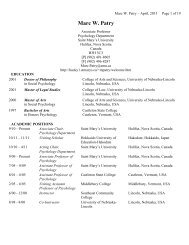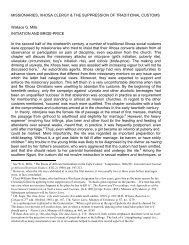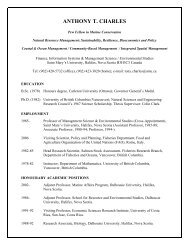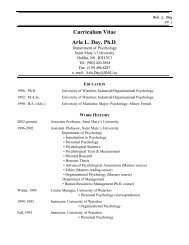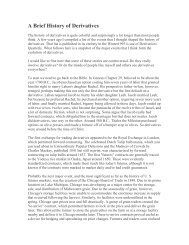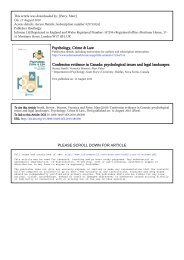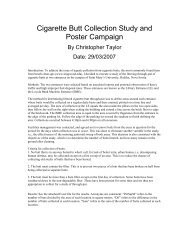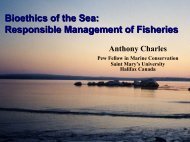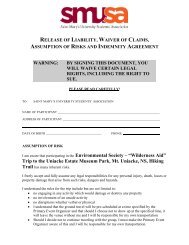Community Fisheries Management Handbook - Saint Mary's University
Community Fisheries Management Handbook - Saint Mary's University
Community Fisheries Management Handbook - Saint Mary's University
Create successful ePaper yourself
Turn your PDF publications into a flip-book with our unique Google optimized e-Paper software.
Introduction<br />
PART TWO:<br />
<strong>Management</strong> Activities<br />
In <strong>Community</strong>-based<br />
<strong>Fisheries</strong> <strong>Management</strong><br />
“My first year on the job, I felt I was constantly dodging bullets because I<br />
was always having to react to new issues being thrown my way.”<br />
-Curtis Falls, <strong>Fisheries</strong> Manager, Acadia First Nation, 10 September 2003<br />
As explained in Part 1, there are many professional and volunteer managers<br />
involved in community-based fisheries management. Many have not<br />
previously with the range of skills that are part of the job. They are learning<br />
“on the job” as they face the day-to-day challenges and opportunities.<br />
Part 2 of the handbook is about the management activities done by fisheries<br />
managers (i.e. including fishing associations, management boards, office<br />
managers, and professional managers) within the context of the various<br />
forms of ‘northern’ fisheries that are the focus of the handbook. Each<br />
chapter in Part 2 focuses on a specific management activity and the knowledge<br />
and skills needed to do it effectively.<br />
Most organizations will not become involved in every activity discussed<br />
in this handbook. <strong>Community</strong>-based fisheries will usually start with a few<br />
such activities, and perhaps eventually take on new management responsibilities<br />
over time.<br />
Though the fisheries management activities in this handbook are presented<br />
sequentially, involvement in community-based fisheries management<br />
does not always happen in any particular order, nor are the activities always<br />
easily separated from one another. <strong>Management</strong> activities in community-based<br />
fisheries management reinforce each other, as they should be<br />
integrated, complementary, ongoing, and simultaneous. This is especially<br />
important for activities such as monitoring and evaluation which can help<br />
organizations assess their progress, reflect on their experiences and make<br />
changes as needed.<br />
The table of fisheries management activities presented below lists some<br />
management functions that do happen as part of community-based fisheries<br />
management. It is based on a similar table in “<strong>Fisheries</strong> that Work:<br />
Sustainability Through <strong>Community</strong>-based <strong>Management</strong>” (Pinkerton and<br />
Weinstein, 1995)<br />
PAG E 2 7



